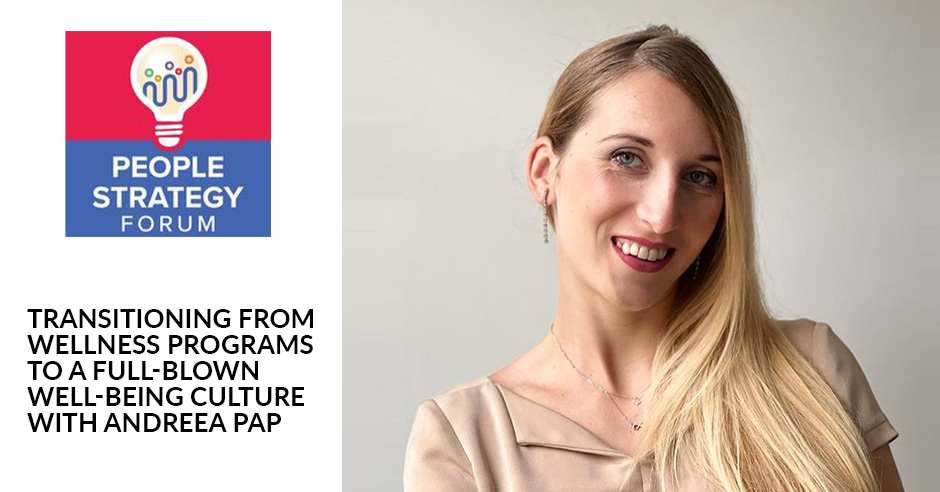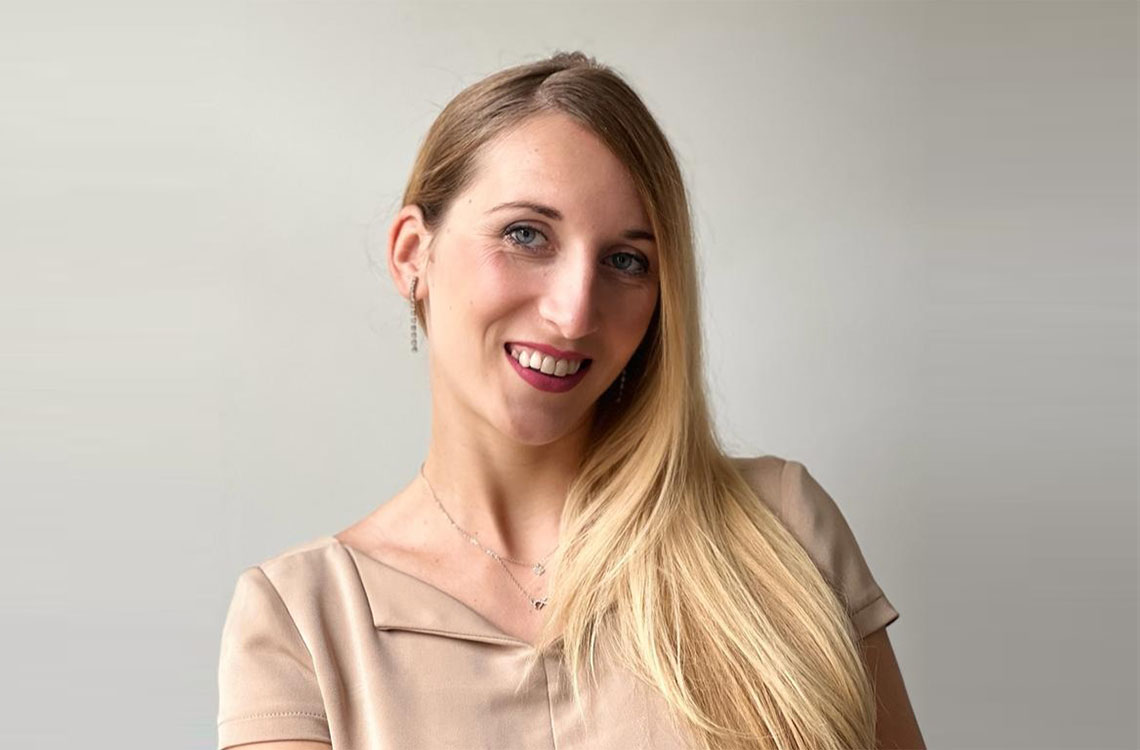Transitioning From Wellness Programs To A Full-Blown Well-being Culture With Andreea Pap

When you can show up as your best self to work, everything else becomes so much better. You become happier, more engaged, and more productive. But this is only the case if you have the work environment that allows you this in the first place. In this episode, we say goodbye to those mere wellness programs and transition to a full-blown culture of well-being with our amazing guest. Andreea Pap is a positive psychology practitioner and Founder of the Happiness Digger, where she empowers teams to create and spread happiness at work and at home. Today, she shows us how we can start planning on the wellness side and let it seep into our culture. From fostering engagement and that sense of belonging to navigating the remote set-up and today’s technology that adds an extra layer of challenge to building a culture, Andreea dives deep into them all. Plus, she shares some great tools and workshops you can take advantage of. Tune in to this conversation and discover the real game-changer for your organization’s culture. Let Andreea guide you toward a well-being culture where your teams are happy and at their best.
—
Transitioning From Wellness Programs To A Full-Blown Well-being Culture With Andreea Pap
We have a lot of our hosts here. I want to recognize Howard Nizewitz. He is a seasoned compensation advisor and HR consultant who has many years of experience. He has been a colleague of mine for quite some time. We have worked at Barclays together a while back. He’s got a lot of experience with those larger organizations and brings a great set of questions and perspective from that perspective.
We also have Char Miller with us. She is what I call a serial entrepreneur. She is a busy woman who is not only a Chief HR officer herself but has done that through history and her past career. She has a couple of small businesses in play, including Mountain & Sea Career Strategy and Mountain & Sea Health Advocacy. She brings that small business perspective to the employee interface piece.
In addition, we have Sumit Singla. He is from India. He has got a large pedigree of consultancy from Aon. He brings an international perspective to the ideas that we are talking about. I’m pleased to have all of them on the show. My name is Sam Reeve. I am the Managing Consultant of CompTeam. It is a compensation consulting company. We consult in talent management aspects. I’m pleased to bring this episode to you.
We were going to be diving into a topic that can be a real game changer for your organization transitioning from mere wellness programs to creating a full-blown culture of well-being. Who’s better to take us through that journey than Andreea Pap? I’m happy to have her on here. She’s the Founder of the Happiness Digger and a positive psychology practitioner.
Andreea is an expert that you have been waiting for on this topic. She’s not another speaker. She’s a workshop wizard. She has these great workshops that I think you would love to learn about. She will tell us a little bit about that towards the end of the show. Her mission is to empower your teams to be happier, more engaged, and more awesome in how they contribute to the organization.
She combines hard science with this infectious energy. She offers a fresh perspective on integrating happiness into your company’s DNA. Let’s go ahead and jump into this conversation. First, I’d love to start by talking to you, Andreea. How did you get into this practice? Tell us about your journey. How’d you get here?
Thanks for having me. It’s a pleasure to be here with you. How did I start it? It’s something that always interested me on the side. I landed a corporate job a bit by mistake and fell in love with the industry. You mentioned Barclays. I worked in payments for several years. I landed there by mistake. I wanted to do an internship in marketing. I fell in love with payments. I was like, “This world is thrilling.” I stayed there for several years.
On the side, I always worked on my well-being. I recognize the importance that this topic has and the things that we haven’t been taught in school or even in university LA later in my career. How to manage yourself, understand your mind and emotions, and leverage what you have to bring to the organization and your strengths.
My passion is something that some people see as something that I need to take care of. For me, that was something that I always wanted to harness. I wanted as an individual to get better, understand how I can use things to my advantage, and be my best self at work. Later in my career, I realized that this has real value. I started integrating it into my workplace.
We will talk about a people group where we did initiatives for our people. I was part of the culture council. We are trying to bring as much knowledge and expertise and trying to put together activities that will make employees happier, feel more engaged, feel happier at work, and ultimately be more productive and bring their best selves.
That’s how it started, but it wasn’t until COVID that I realized the power that this knowledge holds because, at a hard time in history, I realized that I had the tools. I had been using the tools for a long time that were easy for me to apply in such a circumstance. For the majority of people, it was the first time that they were like, “I need to take care of my well-being. I need to go on walks and meditate.” If you want to learn how to fix a tire after it blew up on the highway, you can give it a try. Some people will manage, but at that time, you have to go on, but you are not in the best shape to take in new content and action, for example, fixing the tire.
It’s all about having the knowledge ahead of time. I focus on this preventive phase, where you know what’s good for you, what makes you happy, and what helps you in situations of a lot of stress. When those situations happen, you are well-equipped to take care of them. You know to go through them as well as you can.
It was during COVID that I realized, “This needs to be something bigger.” That’s what I was doing with it. At the time, Happiness Digger started. I started doing work with other companies and eventually transitioned out of my corporate career to do this full-time. It’s been a blast. I have enjoyed helping companies get their teams and their employees equipped with the knowledge first and the tools to be their best selves and be happy at work.
Let’s dive into the knowledge and the tools. The big thing is that when our readers are out there thinking about wellness programs, that sounds clinical. We are talking about happiness. We have heard about the wellness movement, especially in mindfulness after the pandemic. That brought it to the forefront. What do you see as being some of the top issues in companies regarding wellness and happiness?
It’s a strange time. We are at a bit of a crossroads. On the one hand, organizations and individuals have realized that it is important that they have to invest and pay attention to this, but at the same time, it’s an area that is still underinvested. We have the awareness, but it’s lacking a bit of action. When you are talking about wellness programs, it’s the typical things that we see in companies, like gym subscriptions, yoga classes now and then, or bringing in someone who will give massages because employees are stressed.
That’s an ad hoc intervention. It could help at the moment, that day, or maybe that week. It’s not something that, in the long-term, will have an impact. The biggest problem at the moment is we need to be more strategic and put in place end-to-end programs that will address the issue of well-being rather than having ad hoc interventions that you do based on something that comes up in the calendar. You see, “It’s international mindfulness day. Let’s bring someone to do some meditation.”

Well-being Culture: The biggest problem at the moment is we need to be more strategic and put in place end-to-end programs that will address the issue of well-being rather than having ad hoc interventions.
It’s a great initiative, but in itself, it won’t have such a great impact. It’s about putting in place a strategy. I always say, “The same way you plan your financial year. Plan ahead of time what products you are going to develop, where you are going to put your money, how you know your sales strategy, and what targets you are going after the next year.” It’s the same with the well-being strategy. You need to plan ahead of time. It has to be strategic. It has to sit at the core of the organization. It has to be executed throughout the organization.
On the back of that, there is an earlier problem to that, which is that organizations usually rely on 1 or 2 post surveys that they do. Imagine an organization that will take the polls to 3,000 employees once a year. Based on that, they will try to put in place a strategy or try to do things for the next twelve months. It’s irrelevant in this fast-paced world. What is happening now is not what’s going to happen in the next several months.
That’s an underlying issue leaders don’t know what’s happening in the organization. Imagine telling a CFO, CEO, GM, or whoever is responsible for P&L. You can see your numbers once a year. Go ahead and work for the rest of the year. See if you are going to make your target. As someone responsible for numbers, I would check my numbers every week. Every month, I would deep dive into my numbers to see what was happening. Where is it going well? Where is it not going well?
In this case, organizations aren’t doing that with their main resource with their people, who are the ones that are behind the numbers, achieving, or developing a product. It starts with taking the poll to the organization more often, ideally on a weekly basis, rather than having 50 questions. Ask a question. How happy have you felt at work this week?
It’s more valuable to know how people are feeling over time across the organization rather than taking a large survey once a year because there are many things that can impact how you answer that survey at that specific moment. Maybe you had the worst week. Maybe a client went away, or you had a delay in the product. Maybe it was the worst week that you had in the year.
It's more valuable to know how people are feeling over time across the organization rather than taking a large survey once a year. Share on XIf you have to answer that survey that week, it’s going to be more on the negative side. It’s not reflecting the reality. Start by taking the polls to the organization on a regular basis, even if it’s more questions, one question a week for an entire year, and put in place a strategy, an end-to-end program, and what you are going to do across the organization.
There are software companies out there that help do text polling and send out a text to employees. Illumos was one of them. I don’t know if you use a particular platform to do that regular polling, but it’s real-time. You get it across in your text, and it comes at various times of the week. You rule out that good day, bad day types of things over time. That makes sense.
I would love to go back to a little bit of that. You were talking about planning. Executives should be planning around wellness, especially what’s going around the globe. We may have more years like that because of the demographic issues that we are facing. The economy might be struggling for quite some time.
A lot of companies are saying, “We don’t have a lot of money in the budget for compensation and pay. We know that people are going to be under stress because of the economy and what’s going on. We need to think about how to help our people stay engaged and how to help them through this time. What should they be planning for on the wellness side? How can they plan? Can you take us through that?
It’s funny that you mentioned compensation because that’s something that people always think is the number one driver. People will be thinking of compensation in one compensation. Fair compensation is the basis. You have to pay fairly. With compensation, there are plenty of studies all over the world. It’s not the number one driver of people feeling engaged at work or wanting to stay in the company and perform at their best. It’s belonging.
It’s a broad concept, but it starts with something at the core, that is, the purpose and giving people a purpose or something more than that. You work. We can make money. The ultimate goal of all companies is to give them that sense of why. Why are you doing what you are doing? I always shared the example of my own experience when I was working during COVID in this large corporation. I was working in the airline industry, which, as you can imagine, was the worst industry to work with. It was chaotic. There was so much going on. Their planes are grounded.
It was a lot, but I found my why. It’s nothing that the company was doing on a large scale, but what my account teams and I were doing, was helping those airlines first, fly when possible, help repatriate people, and take people back to their loved ones and families. For me and my accounting, it is such a great way to stay focused and engaged and work many hours more than I would work on a normal schedule.
I found this why. I realized that what we were doing, getting money back to people, people who were asking for refunds, was important in a period when everyone was losing their jobs or needed money to take care of loved ones. Organizations need to focus more on this and create the why. It’s not the vision, mission statement, and values around that. You have to make it so that it’s living and breathing through the organization. Everyone understands their contribution to the work, how they are contributing to their team, to the larger group in the organization, and to the organization as a whole.
It’s the core of every business wanting to do something around belonging. You have to make sure that that’s in place. After that, it has to be something that lives and breeds in the organization. You have to make sure that belonging is something that people feel. This question that Gallup has in the poll. At the start, people thought, “This is a funny question.” They ask, “Do you have a best friend at work?” It’s so indicative of people staying in the organization. They were saying it’s the number one indicator when it comes to retention.
You have to make sure that belonging is something that people feel. Share on XSomething as simple as, “Do you have someone at work that you relate to well?” It’s something that leaders sometimes don’t pay attention to, but it’s critical. Belonging is what they should focus given that compensation might be a challenge, and it’s working on the why and creating a space where teams connect. Nowadays, it’s more important.
I find that both things are hard to do in a virtual environment. Lots of people lose their sense of why because they are sitting in their room or at the dining table. They are working on this little piece of work that they have to do. They don’t have visibility on the bigger piece of how they are contributing to the organization.
Connecting in this virtual, hybrid environment is sometimes a bit harder. That’s where leaders can play a role in bringing everyone together and creating the space and time in the agenda of people to connect on a different level. The biggest part of my work is bringing people together, connecting teams, and giving them the time and the space to do something where they learn, connect, have fun, and walk away with some tools they can use later on.
Can you tell us a little bit more about what that looks like? From the virtual sense, we are in the remote age where a lot of the workforce is remote. You mentioned one thing. Gallup asked this question, “Do you have a friend at work?” If you are working remotely, you may have a friend at work, but there are still over a Zoom call away or whatever platform you might use. Is there a way that is more effective for remote companies or companies that are remote first to help encourage that engagement and sense of belonging?
It is a bit of a shift in mindset when it comes to how you come together. You can come together to a meeting and chitchat for five minutes. How are you? Everyone will say, “Fine.” Five minutes go by, and you haven’t had any conversation. You haven’t connected with people, but you can also come to the meeting and say, “Let’s go around the room. Tell me what’s the best thing about this month. Tell me one thing that you are proud of this week. What have you achieved last week? What was your biggest a-ha moment last week? What did you learn?”
You create a space in which people connect. It’s a bit uncomfortable at first because you think like, “Maybe it’s a bit too sensitive. People will feel they don’t want to share.” The reality is that if you come and you have a genuine willingness to learn about people and make sure they have the space to connect, people are open to sharing. Beautiful conversations come out of these little moments. It doesn’t have to be much.”

Well-being Culture: The reality is that if you come and you have a genuine willingness to learn about people and make sure they have the space to connect, people are open to sharing.
I remember I was doing an exercise. I was asking people to bring the thing they love the most. Someone brought a picture of themselves with their dad and the rose. They told the story about this picture. Everyone was in tears. It was such a beautiful story that you wouldn’t have known otherwise. I created the space. People are usually eager to open up. They want to connect with others. It’s in our nature. You have to give them the space.
As an American, sometimes Americans, especially in the United States, are driven to get things done from a work perspective. Sometimes, when you bring up, like, “Let’s share these moments so we can connect more.” As a leader, I’m like, “Am I wasting people’s time? Are they going to accept this as something that’s part of team building?” What are your thoughts, Sumit? I’d love to hear your perspective on the different cultures you have interacted with. What do you think?
I have encountered some cynical people. It’s always two angles. First, give them the knowledge. That’s what I also do with my workshops. I show them the data, case studies, and their productivity. It is something that we are all worried about. It’s impacted by well-being. Once you show some data, and you talk a bit about it, they are like, “When I’m tired or in a bad mood, I don’t have a good day.” It’s because the two are interlinked. You can’t expect that you are in a bad mood, angry, and frustrated. At the same time, you are productive, doing your best work, and being creative and innovative.
I always try to show them the data and talk about some research. I love Barbara Fredrickson, who talks about positivity and how it opens our awareness. It broadens our vision and how we take in more. We are more creative. I like to tell people a bit about the research, science, and data of how this helps their productivity. I want to get people to do stuff.
Even if they don’t start necessarily eager to do stuff, I like to get people to experience things, do the exercises, and do the different interventions. By the end of the session, they all walk away with a realization. I do feel better even if I arrive at the session stressed, angry, or frustrated. I’m living in better spirits. I feel better. I’m ready for work now.
It’s a bit of taking people through that journey. Sometimes, the realization comes sooner. Sometimes, later. All people will leave at the end of an hour of a workshop with the realization, “Maybe there is something there. I should try to give it a go.” That’s something that we underestimate, but we don’t know what we don’t know.
There are many things that are good for us. There are many things that have been tested and researched that have a positive impact, but not all of them are intuitive. If you don’t have the knowledge, it is quite hard to put it into practice. That’s how I go about it. I give them the research, the data, the knowledge, and the actual doing. They can experience how it feels in their body and how leaving the session, they are ready to go for the day.
What do you think, Sumit?
Those are interesting ideas from an international perspective. At a deeper level, people are the same everywhere. As an employee, my ask from employer or colleagues would be simple. Do you see me? Do you hear me based on what you see and hear? Will you act on what you have seen and heard? That’s all there is to well-being.
If I feel invisible and nobody cares, that’s a lack of inclusion. If you are not listening to me, that’s a lack of psychological safety and trust. If you are not acting on what the needs of a person are, it will impact their well-being. The difference I have seen is in many cultures, especially in the Asian side of things, a person may not be upfront and candid, especially with a senior person. When you are dealing with folks across hierarchies, you might be a little hesitant and assume that the person is a leader. They should have enough sense to figure out what I require. They may not be as upfront and as clear as an American is likely to be.
That can be a challenge in cross-cultural management when you have an American leader who’s managing an Indian workforce because the American leader might assume that if they have a problem, they will come to me and talk to me. Simply saying, “You are free to walk up to me,” is not going to make a big difference because people are a lot more respectful of hierarchy. They don’t want to rock the boat. Leaders need to figure out how to look for signs. The idea we discussed about regular listening sessions or regularly collecting feedback goes a long way in making the intent clear.
Direct managers need to be tuned into their employees. You are interacting with them on a regular basis. We all know everyone goes through stuff in their lives. If someone is having a situation or a personal situation, it’s going to impact their performance. How do you get managers to tune in and act upon it? It’s like, “Keep your stuff at home.” People think they are afraid to say, “My father is sick. My child is sick. I’m going through a horrible divorce.” How do you get people to feel comfortable sharing that information and getting managers to react and accommodate people who need assistance?
For many years, we have left mental health or outside work problems at the door. Get into the business and do the work. You can deal with your problems later. It’s because we are now working from home. There is no more like work and life. It’s life, and work happens in between. That integration is there physically and metaphorically.
Unfortunately, I have to say, thanks to COVID, that we realize that we need to talk about these problems. What people go through impacts their work. COVID had such a negative impact on many people’s lives on such a large scale that it was obvious that we need to talk about it. We can’t leave it at the door. We need to support our people. Lots of organizations did great work during that time, but it comes down to having leaders equipped to have those conversations.
I don’t think this was the leader’s job. You wanted to know that the person was happy on the job, they were doing well, they were performing well, and they didn’t have any difficulties. Maybe you were working with them on some personal development where they wanted to go in their career. That was pretty much it. I don’t think they historically dealt with how you are feeling. What are your stress levels, and how much anxiety do you have?
It starts with training the leaders and giving them the knowledge and the tools to deal with these situations. The most important thing is to recognize the signs, either intervene themselves or direct them to someone else who can help them, an external professional or the company’s assistant. I see some leaders already doing that. I have an example where a leader referred someone to me. I was saying, “You are having a hard time. Would you not want to talk to me?” She’s like, “I know Andreea. We do not want to talk to her and see how it’s going.” We are still talking.
It’s about leaders recognizing those signs. You don’t have to have all of the knowledge as a leader. That’s another big burden to put on leaders that are already stretched. Unfortunately, the data, if you look at stress levels and burnout levels for leaders, are also at an all-time high. It’s difficult to put the burden on them to be able to deal with these situations and help solve a problem, but for them to recognize what’s going on and someone is feeling unwell, maybe has a bit more stress than usual, it’s feeling a bit more anxious than usual and point that out and having a conversation and offer support for that person is the first step, but it starts with having the knowledge.
We still have a lot of work to do in equipping the leadership with the knowledge overall. If you look at the amount of new leaders that are in the workforce from COVID on, you do see a lot of new leaders coming in and people that have been made in stressful situations where they had other priorities. They need to catch up with getting settled into the role, understanding, and having the knowledge to signal this type of thing.
What Sumit was saying is true. If you don’t have a psychologically safe environment, and that’s something that your leaders should already be well equipped to do, you are not going anywhere. That is the foundation. From there, you can build and have those conversations with your team, pick up on the signals, and help your employees.

Well-being Culture: If you don’t have a psychologically safe environment, and that’s something that your leaders should already be well equipped to do, you are not going anywhere.
I’m a seasoned leader. You got me thinking about this because a lot of my HR background is in healthcare. Healthcare is always a challenge for a leader. What you get me thinking about is that out of the hundreds of leaders, I spent a lot of time sitting around with leaders, and you have to think about the day in the life of a leader. For example, a lot of feedback I got from leaders is, “What are you talking about? I don’t have time for one-on-ones.” I’d ask them, “When was the last time you had a one-on-one with your employee?” They’d say, “Several months ago.”
I was always at all these different meetings, the executive meetings, the board meetings, and the manager meetings. The day of the life of a leader is that every week they have, like, every Monday morning, there’s the manager meeting. Every Wednesday, there’s the finance meeting, and then there’s this. Every leader has 200, 300, or 400 emails a day.
You talked about the email about wellness. They are skimming through it and the paperwork. You are stuck in your office behind your desk. The feedback I got from the employees is like, “I never see my boss. I work hard. I don’t even know what the CEO looks like this year because it changes every couple of years.”
What resonates with me is the responsibility from a talent management perspective. As a talent management guide of the organization, we need to be cognizant of the time that we keep pulling the leader away from that one-on-one time with the employee and structure that into accountability. One quick example is when I had my own company, and because I worked with CompTeam and had a different perspective about talent management strategy, every single meeting, be responsible about the number of meetings you are pulling your leaders into but structure those meetings.
Here’s what we did. Talk about operations, finance, customers, or patients. In every meeting, we should always have time for the people talk, the time to talk about wellness, how you are feeling at work, and the soft stuff. I have to say, no offense to my financial colleagues, but some perspectives of senior leaders are that the people stuff is squishy and not important. We need to be on target, productivity, and return on investment. It was the softies like me that would say, “No, the relationships are important.”
You should know that Sally’s mom is in an intensive care unit, or George’s son is going off to college or having suicidal issues. You don’t need to get in from a HIPAA standpoint into their private information, but you darn well should know what’s going on in your employee’s life with what they are comfortable sharing with you. That was a big, long monologue, but I love what you are saying. It’s a cultural aspect. Many of us are cultural leaders. We need people like you to help us think out of the box, be more progressive, and say, “This does help us with our bottom line.”
There is so much data out there now. There is no more doubt like this fluffy well-being or intangible. What is it? If you are feeling well, you are going to do well. It’s intuitive. In the business, it seems like the logic goes out of the window, and everyone is focused on the numbers, but the numbers come from the people. The fact that you won’t take care of the people that generate the numbers. If the people are not there, the numbers won’t be there. It’s pure logic.
If you are feeling well, you are going to do well. Share on XNowadays, the data is there. There is so much research. There is great research that came out in 2023 around how the best companies to work for this yearly ranking outperform the stock market. If you look to invest in these companies that are the best places to work, they outperform the stock market. It’s not because they don’t care about the numbers. They do, but they care about the people. People vote for these companies as being great places to work. They feel well, engaged, and happy at work. As a consequence, with hard data, they are performing better in the stock market.
The data is there. This is one of the studies, but there is also a great study that was done with BT and call centers around the UK. It’s fascinating because, for the first time, they managed to get down and be specific. They measured the weather. We all know that when it’s sunny outside, we feel happier versus when it’s not sunny outside. They were able to measure, based on how the weather was, how much exposure people got to the weather in the call centers, and how productive they were.
The result was unbelievable to see that they were much more productive when it was sunny outside, and they were exposed to the sun. In the call center, when they had lots of windows to the point that they were able to get down to knowing that these types of people, one day had sun versus the people that were in not sunny places made 12% more sales. It’s such a small variable. You cannot influence the weather. The idea that something that makes us feel happier has an impact on productivity and increases sales by 12% is hard data. You can’t go around it.
I had a learning and development department. They all had the middle cubes, whereas all the managers and directors had the outside cubes and no sunlight. I agree with it. I want to ask you a quick question about your opinion on one other topic because I can be chatty. I have been noodling on this because Sam and CompTeam had an executive conference for artificial intelligence and how that’s impacting talent management strategy.
I wanted to get your view on this because, to me, artificial intelligence can free up, like tracking the numbers, checking emails, and streamlining time management so that our executives can spend more time sitting down with an employee and saying, “Sorry, you don’t have a window. How can we help you have a better work environment?”
I feel that artificial intelligence is going to help free us up to build better bonding and community to have conversations. Technology can deal with all that stuff that is taking all the time away from our leaders. The second comment is the span of control and evaluation. I have a leader with 40 to 50 employees. How can they reasonably meet with their people on a one-on-one? It’s a two-part comment. What are your feelings about artificial intelligence, and how do managers or executives deal with spanner control? What are your thoughts about that, Andreea?
Everything that has to do with workload management. It’s welcome, I think. AI that it’s out there is going to be great for us. If used in the right way, it also has the potential not to entangle us in some other things. A simple thing that I find fascinating is that I can play my emails while I do something else in the house. I don’t have to read the emails. I can play the emails. There is already assistance to write replies if you don’t have to type the useless parts of the emails. You are doing the bits at the start and the front, and you want to put the content.
You can’t email, “This is what I think.” You have to make it into a formal email. If you have an assistant who can help you draft emails that pick up on things that you haven’t, one of the traps is when you have lots of emails piled up, and you have to go through all of them. What if AI can tell you, “These are the main points discussed in these twenty emails over the past several months. What do you want to reply?”
It has the capacity to free up a lot of our time. Workload management is basic. You cannot do other things when you have your CEO telling you to do the numbers or to prepare this report. As much help as we can get with that will free up the time. When it comes to how you manage like you are saying, if you have many people under you. You have 40 employees. How can you manage that as a leader?
It is time to think about the structure. Maybe 40 people under one leader is a bit much. If you want to have someone who cares about the employees, you need to think it’s not about having as many employees as you can under you, which traditionally was what people were looking for. It’s not quantity. It’s quality. We need to change the mindset and look at, “How can we make sure that the leader can take care of the people that they have in their teams?”
If you want to have someone who cares about the employees, you need to think it's not about having as many employees as you can under you. Share on XIt is basic, but it gets overlooked because you get filled with meetings. Not being a people leader or being a leader and not having time for your people is not ideal, to say the least. Hopefully, we will see a shift in how organizations operate. It should be a metric that all leaders are measured on. Numbers are metrics, but how are your people doing? It’s not about taking the measure once a year. How were your people doing last month? Were your people engaged at work? Were they happy? Did they have enough communication from you? Were they in touch with you? Are you there to support them?
I was lucky with the leaders that I had in my corporate career. I had a particular leader that will always stick in my mind. He was always there. He was a busy leader. We also had our one-to-ones, but if I needed him, he made the time to be there. I felt that I was a priority for him. It feels nice to know that I have a leader. If I run into some trouble or need his support, guidance, and a second pair of eyes to look at what I’m doing, my leader is there.
There is nothing more powerful than having the feeling that someone has my back. I have a leader that is not the one that’s saying, “You worked hard this month. Well done. You didn’t meet your numbers. It’s not so good.” It’s someone with your back that is there when you need them and there to you no matter what your needs are, be it work-related stuff or even personal stuff.
Thank you so much. I love these discussions.
We are approaching the top of the hour. I want to take a quick moment to acknowledge our sponsors and also to tell you about our book that we have on the workforce experience. Sumit and I wrote this over the past few years. I wanted to make sure that we share this with you. It’s available on Amazon and Kindle. Feel free to take a look at it.
I want to acknowledge our sponsor, which is TMA USA. We were talking about getting to know your people more. This is one of those assessments that you can use. It’s out of the Netherlands. It’s designed to better know your people. It’s based on positive psychology, as you were discussing. It can be an impactful tool to learn about your people. If you are interested in taking a demo or would like to do an assessment with TMA, let me know. I’d love to take you through that. Andreea, I know that you had a few things that you wanted to share with our readers. I know you have some great tools and workshops. Can you tell us a little bit about that?
Workshops are the things that I enjoy the most. I like bringing the knowledge and the action to people and putting them immersive in positive psychology to experience the benefits that it can bring, not only at work, because we talked a lot about work, but we know how you feel at work, you are bringing that home no matter what, as much as you want to live it at work, that’s simply not possible.
That’s what I do workshops. I love doing workshops on mindset. That’s the foundation of everything and what we were also discussing before. Empowering employees to be in the right mindset and to take advantage of what leaders and organizations have to offer is critical. Working on the foundation is something I always try to get in companies to start with.
I work on the mindset first. I do workshops on strengths. It’s one of those things that we haven’t been taught to appreciate and leverage in our lives. We have always been taught that we need to look at our weaknesses and improve those areas of improvement. We need to work on getting better at the things that we are not good at. The science is clear, saying, “You should know what your strengths are. You should build those up. You should strive to go from good to excellent. That’s where it will make an impact in your career and personal life.”
It goes back to productivity. When you are working from your strengths, where you do what you love, and what you are good at, you are happier and more productive. It’s this virtuous cycle. I also workshop on energy and how to make sure that we understand how to manage our energy, how to sustain our energy, how to recover, and why rest is critical to make sure that you can sustain your performance throughout the day, week, month, year, and many years to come. There is a lot to do for a long period of time and go. It’s not sustainable for the long term.

Well-being Culture: When you are working from your strengths, where you do what you love, and what you are good at, you are happier and more productive.
I do workshops that are a bit more fun. I play something that I enjoy. Adults do little of that. I do workshops on play and trying to bring play into the workplace. I am also using a game that’s called Happiness. It’s an online game where we solve workplace dilemmas in a fun way using positive psychology solutions. It’s a way to engage people in a conversation where nobody has to come up with a challenge or a problem that they are facing. They are simply posing a dilemma that the system is showing them. They together try to solve it.
Those are some of the things I do. I do have a tool that I also encourage companies to use for the employees to gift for Christmas, International Happiness at Work Week, or Mental Health Day. Give them another tool to use positive psychology and act and take care of their well-being. These are called Happy Action Cards. The idea is that you would have 52 cards inside the box. You would use one card every week. You would take action on your happiness.
It’s my intent to make it so that people have access to the knowledge in a simple way. They can do something that impacts their happiness. You have things like cards of gratitude. For example, the first one will be to offer a little token of appreciation to someone. The idea is that you have to try every day for that week to offer a token of appreciation. It’s the small things that, over time, accumulate and impact your well-being.
The idea is also to make sure that people experience different things and they build their portfolios of solutions and things that work for them. Not everything will work for everyone, but it’s important that you try and realize, “I did this, and it felt great. I should incorporate it into my routine. I should do it more often.” I do offer this on my website, which is Happiness Digger. I have a special discount code, which is Happiness. If you want to get yours, it’s 30% off with the code Happiness.
Thank you so much. I can make sure I get myself a set for sure.
I feel happier already.
I love the idea. It’s awesome.
Thanks.
Thank you so much, Andreea.
It’s been a pleasure. Thank you so much for being a guest on the show.
It’s my pleasure. Thanks for having me. It was great chatting with you all. I hope that you are living a bit happier, inspired, and ready to take a bit of action.
Thank you, everyone. We will see you in the next episode. Take care.
Thanks, everyone. Have a good day.
Important Links
- Happiness Digger
- TMA USA – Facebook
About Andreea Pap
 Meet Andreea, the Positive Psychology Practitioner, and founder of Happiness Digger. Andreea is a speaker and workshop facilitator on a mission to empower employees to create and spread happiness at work and at home. By harnessing the science of positive psychology and more than 10 years of experience in the corporate world, Andreea focuses on bringing fun and meaningful workshops into organizations in order to create happy work cultures.
Meet Andreea, the Positive Psychology Practitioner, and founder of Happiness Digger. Andreea is a speaker and workshop facilitator on a mission to empower employees to create and spread happiness at work and at home. By harnessing the science of positive psychology and more than 10 years of experience in the corporate world, Andreea focuses on bringing fun and meaningful workshops into organizations in order to create happy work cultures.




